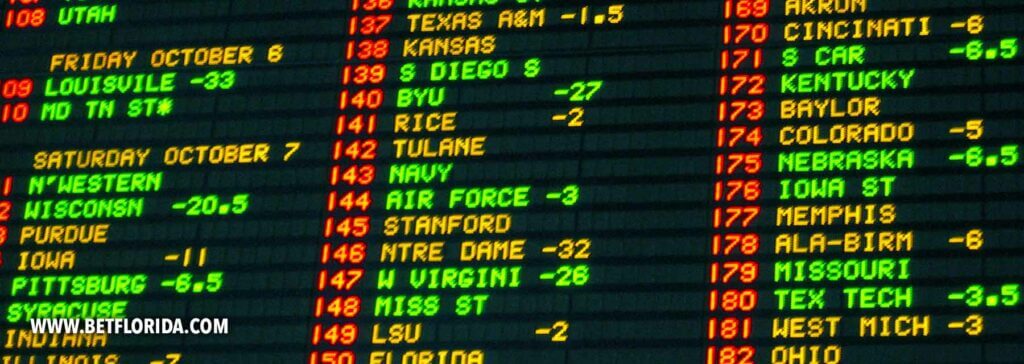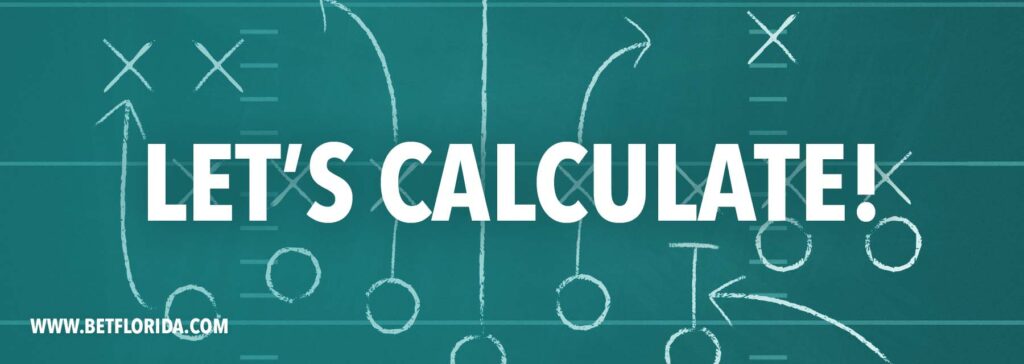What Are NFL Odds?
As stated before, understanding how to read the NFL odds is essential when betting on American Football and the NFL. These are values used to depict the probability of a specific event occurring.

By making this information available to bettors, they are then able to choose the most profitable wagers to place.
Before calculating any potential payouts, you need to decide which odds format you will use. The decimal, fractional, or American formats represent the same information in different ways.
It’s a matter of determining which you understand better. By multiplying your chosen NFL odds by the value of your wagers, you will find the potential payout should your bet be successful.
When doing these calculations, remember to account for your original wager to determine your profit. This addition is applicable for the fractional and American formats.
In the table below we show you the same odds in different odds types.
| Team | Decimal Odds | Fractional Odds | American Odds |
| Miami Dolphins | 2.20 | 6/5 | +120 |
| Jacksonville Jaguars | 1.71 | 71/100 | -140 |
While sportsbooks may display these three formats differently, they all reflect the same information. Using the example table above, below are explanations of the three primary forms used to display betting probabilities.
Decimal Odds
The decimal format is also known as the European, digital, or continental odds. The decimal is the preferred format among bookies from Europe, New Zealand, Canada, and Australia.
When looking at these numbers, it’s very easy to spot the favorite or underdog, making it an accessible format to understand.
Calculating your potential return on a bet is as simple as multiplying your stake with the values given. If your chosen wager is successful, it shows you exactly how much you will receive.
It is essential to remember that this total includes your original stake. So to calculate your profit, subtract that total.
For example: if you place a wager of $100 on the New England Patriots with 2.20 odds, your payout for the successful wager totals $220. After deducting your original stake, your profit on this wager is $120.
The decimal format provides sports bettors with the clearest probabilities, allowing them the chance to maximize their winning potential. As a result, this format is the most popular amongst many of the best betting sites.
Fractional Odds
Also known as British, UK, or traditional odds. It is the preferred format amongst British and Irish bookmakers. Fractional odds are the most widely recognized as it is used by the biggest bookies worldwide.
This format is typically displayed using a hyphen (-) or slash (/). For example, odds that are announced as six-to-one are displayed as 6/1 or 6-1.
As per the above example, this listing says that when placing this bet, you could win $6 for every $1 that you wager. The potential win total is in addition to your initial bet of $1. Resulting in a total payout of $7
American Odds
The American format is also known as Moneyline odds and the most popular choice of sportsbooks in Florida.
The format of choice for online sports bettors in the USA, it makes use of positive and negative figures to depict the odds. The number given shows how much you should wager to win $100.
A negative (-) symbol shows the match favorite with higher values reflecting a higher probability for the team to win. For example, a team with -180 has a higher chance to win than a team with -120.
On the opposite end, a positive (+) symbol shows the underdogs with higher values reflecting a higher probability for loss. For example, the team that has +170 is more likely to win than the team with +400.
In terms of the wager itself, this format uses $100 as the base value for your stake. If betting on the favorite, odds of -150 shows that you risk $150 to win $100 potentially.
Whereas underdog odds of +150 show that you could bet $100 to win $150 possibly.
Understanding Odds, Lines and Payouts
As stated before, odds are used to convey the projected likelihood of a particular event in an NFL game. The three main betting lines include even-money bets, point spread bets, and the two-way action. Here are some explanations and examples of how to read these lines.
| Teams | Even Money | Point Spread | Two-Way Action |
| San Francisco 49ers | -180 | -6.5 | 38.5 |
| Los Angeles Rams | +160 | +6.5 | 38.5 |

Even Money Bet
An even-money bet is also known as a 50-50 bet with 1:1 odds. With no specific probabilities, the bettor stands to win or lose the same amount. The bookmaker stands a chance to make more from this wager, with no real advantage to the bettor.
If the bet is successful, the bettor will double his money. On the other hand, if they lose, the bookmaker keeps the wager placed.
This line is the most preferred wager for new NFL sports bettors as there are no specific point spreads involved. This bet is as straightforward as merely wagering if a team will win or lose.
Point Spread Bet
The point spread in NFL sports betting is the most popular bet amongst bettors, especially beginners. Spreads are not set as a points margin prediction, instead of predicting the balance between bettors wanting to bet on the underdogs or favorites.
This practice prevents sports bettors from only wagering on the favorite NFL teams, leaving the bookmakers to cover the difference and operating at a loss.
Thus, bookmakers make use of the spread to even out betting between two unevenly matched teams. The wager results are determined by either subtracting or adding the odds to the final score.
In the above example, the San Francisco 49ers are the favorite to win this match, and the Los Angeles Rams the underdogs. The Colts needed to win by at least 7 points for the bettors to win if this was their wager. For wagers placed on the Bears, the team needed to either win or lose by 7.
Two-Way Action
This type of bet is most commonly known as the over/under bet. In terms of NFL sports betting, these lines are typically set between 38 and 60. Similar to the point spread, this wager is when a bettor predicts the scoring total.
The scores of both teams are combined, the bettors place their wagers on whether the total will be higher or lower than a particular number.
Referring to the above example again: if the set amount is 38.5 and you wager over, the total score must be 39 or more. For an under bet, the score must total 38 or less.
Understanding Probability in Odds
Understanding how to calculate implied probabilities is a useful tool to have when gaining the upper hand in sports betting.
By calculating the probability of an event, you determine the likelihood of the said event occurring divided by how many possible outcomes there are.
No matter what type of wager you are placing, it will help you decide which is the best option. This information goes a long way to boost your chances of becoming a long term winner in NFL sports betting.
To select the most valuable wager option, you need to calculate and understand the implied odds of the bet.
These calculations will assist when assessing the potential value of your wager regarding the odds of a specific outcome.
Odds Probability Calculator
As discussed earlier, the three formats are decimal, fractional, and American, each with their formula to calculate probability. Refer to the example table and equations when calculating percentages.
| Odds Format | Represented As |
| Fractional | 5/2 or 5-2 |
| Decimal | 1.65 |
| American | -120 or +140 |

Fractional Odds
This format reflects your potential return on a specific wagered amount. In terms of the example above, for every $2 wagered, you could win $5 back.
In order to calculate the implied probability for fractional odds, the equation is:
Denominator ÷ (Numerator + Denominator) = Implied Probability × 100 = Percentage
2 ÷ (5+2)
2 ÷ 7 = 0.286 × 100 = 28.6%
Decimal Odds
This simple reflection of the return that you could expect on each unit wagered. When referring to the above example, this means that for every $1 placed on a successful outcome, you will win 0.65 profit.
To calculate the implied probability of these odds, we divide the stake by the odds. The equation looks as follows:
Stake ÷ Decimal Odds = Implied probability × 100 = Percentage
$1 ÷ 1.65 = 0.606 × 100 = 60.6%
American Odds
This format is also known as the “money line” odds and shown in two different instances.
Negative Values: -120
In short, the “minus money line” means that you need to bet $120 to win $100. If the wager is successful, you will make a $100 profit.
To calculate the implied probability, the equations will look like:
( – (minus moneyline)) ÷ ( – (minus moneyline)) + 100) = Implied Probability × 100 = Percentage
( – (-120)) ÷ ( – ( -120)) + 100)
120 ÷ 220 = 0.545 × 100 = 54.5%
Positive Figures: +140
The “plus money line” means that you need to wager $100 to win $140
The equation for this format is as follows:
100 ÷ (Plus Moneyline + 100) = Implied Probability × 100 = Percentage
100 ÷ (180 + 100)
100 ÷ 280 = 0.357 × 100 = 35.7%
To convert one odds format to another, you first need to calculate the implied probability. From there, the following reversed formulas apply:
1. Fractional Odds
(100 ÷ Implied Probability) – 1 = Fractional
(100 ÷ 25) – 1
4 – 1 = 3
Expressed as 3-1
2. Decimal Odds
100 ÷ Implied Probability = Decimal
100 ÷ 75 = 1.33
3. American Odds
(Implied Probability) ÷ (100 – Implied Probability) × 100 = Minus Money Line
(75 ÷ (100 – 75)) × 100
(75 ÷ 25) × 100
3 × 100 = -300
Or
((100 – Implied Probability) ÷ ( Implied Probability) × 100 = Plus Money Line
((75) ÷ (25) × 100)
3 × 100 = +300
While there are numerous online calculation tools at your disposal, it is essential to know how to calculate and understand these conversions. There is no harm in having this knowledge. It can only add value to your sports betting practice.
Knowing these calculations can improve your ability to spot a valuable wager. Over time it will become instinctual to assess value when presented with probabilities.
If you have a great understanding of how the NFL odds work and also the important rules in NFL. Then you have a great basis to be a successful online sports bettor.